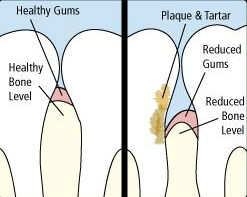The first symptoms of periodontal disease may not be easy for you to recognize. It isn't too difficult to overlook your bleeding gums and bad breath— especially if you're a smoker — because these symptoms often come and go for long periods of time. But these early warning signs may indicate bigger problems ahead.
Periodontal disease often starts as gingivitis, a bacterial infection that causes inflammation of the gum tissues. If left untreated, this condition can progress to periodontitis, which results in loss of the bone that surrounds the teeth. When bone tissue is lost, the teeth and gums begin to separate, forming pockets that provide an ideal environment for bacteria to thrive. Ultimately, the disease may cause tooth loss, painful abscesses, and even systemic inflammation.
Brushing and flossing daily, and having regular professional cleanings are the best way to prevent periodontal disease. If it does develop, a number of treatments are available. Evaluating your oral hygiene techniques and seeking to improve them is a first step at control. Your dentist can also remove plaque and tartar with special tools, in the cleaning technique called “root planing” or “root debridement.” In some cases, periodontal surgery may be necessary.



